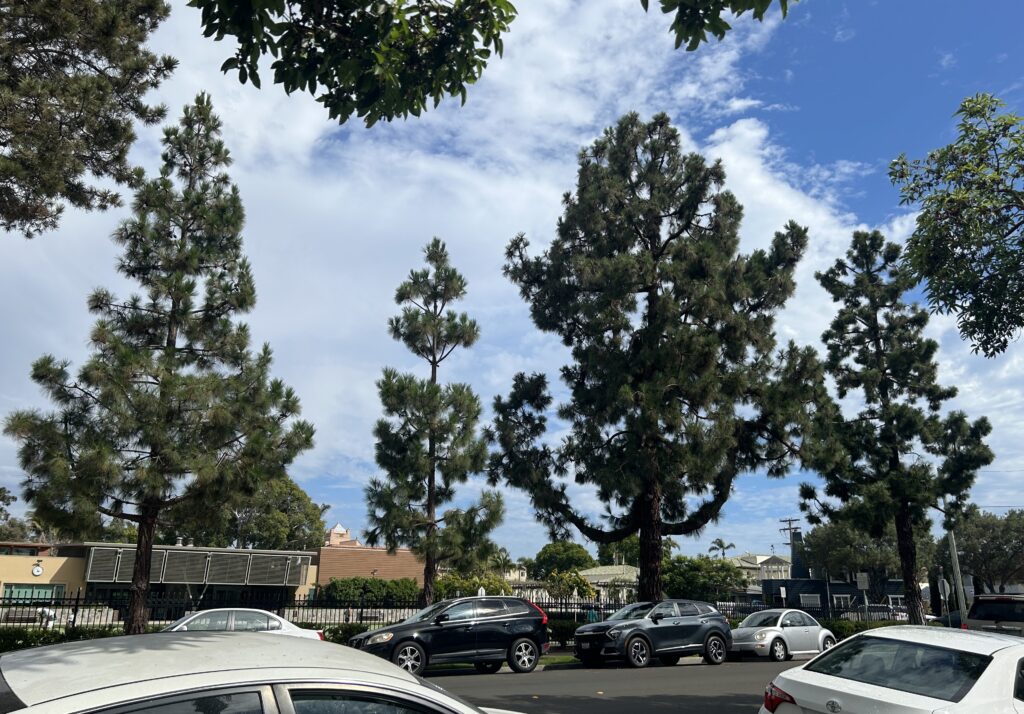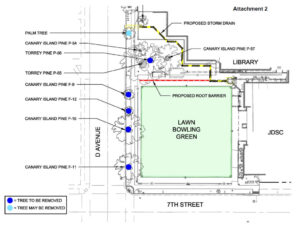
Four Canary Island pine trees will still be cut down after public dissent prompted the Coronado City Council to reconsidered its July decision to remove them.
“I’m asking for reconsideration because I don’t think the community agrees with our decision,” said Council Member Casey Tanaka, who called for the matter’s reconsideration at the Aug. 15 City Council meeting.
 But the rest of the council ultimately upheld their original choice to remove the four trees adjacent to the lawn bowling turf at the John D. Spreckels Center in a 4-1 vote. Tanaka voted in dissent.
But the rest of the council ultimately upheld their original choice to remove the four trees adjacent to the lawn bowling turf at the John D. Spreckels Center in a 4-1 vote. Tanaka voted in dissent.
The trees came under scrutiny because their roots host puffball fungus, which yields large, hard mounds rendering the lawn bowling green unplayable.
The Canary Island pine trees are on the city’s restricted tree list, largely due to their roots. Staff reports said a root barrier might work, but some pointed out that a tree losing a significant part of its root system could cause its own problems.
Collectively, the council said it was a shame to lose trees – but that removing and replacing them was the most economically and logically prudent solution to the fungus problem. The two oldest trees are about 50 years old, while the youngest is about a decade old.

It will cost about $6,000 to remove the four Canary Island pines, along with a nearby, unhealthy Torrey pine that is hindering the growth of other trees. By contrast, a root barrier would cost about $60,000.
“I’m confident that the council’s original decision was the right one,” said Coronado Mayor Richard Bailey. “It’s not necessarily that they’re the wrong trees, it’s that they’re in the wrong location, and that’s why they’re on the restricted list.”
Even without a changed decision, council members agreed that hearing again from city staff, fungus experts, and the public again was fruitful. Much of the online backlash against the July decision was that the title of its agenda item did not mention tree removal, and instead referenced only the revival of the lawn bowling green, so citizens said they were blindsided by the vote, unaware it was even up for debate.
While July’s meeting had more supporters of tree removal – mostly members of the Coronado Lawn Bowling Club – during public comment, speakers at Tuesday’s meeting were more evenly divided, with more citizens speaking on behalf of the trees. Council Member Carrie Downey asked that future agenda items related to tree removal be included more prominently in pre-meeting agendas.
Trees removed, but not replaced
Public dissent was not tied to the four trees specifically. Many residents complained that city trees were removed near their homes and then, years later, had still not been replaced. They worried the same would happen with the D Avenue trees.
One example given was along Seventh Street, which is also adjacent to the lawn bowling green, where trees were removed but never replaced.
There is a minimum, one-year waiting period between removing one tree and replanting another in the same spot because sufficient time must pass before former roots decay enough to support a new tree.
“We have just under 9,100 street trees in this city, and that doesn’t count all the trees on private property,” Council Member Mike Donovan said. “We’re talking about four trees here. It’s a bit surprising to me in this discussion that we haven’t followed up very well on replanting trees.”
Donovan cited some of the city’s pro-tree programs, including giving residents free trees, and noted that he has seen the overall number of trees increasing over the years, even with tree removals, and credited the city’s efforts to increase its tree population.
“Still, the best option that gives us the greatest probability of success is to take the four trees out,” Donovan said. “I would also advocate that we plan on putting the same kind of trees along Seventh Street, where we apparently broke our promise.”
Donovan and Downey both tried to include the replacement of the 7th Street trees in a motion to uphold the council’s original choice to remove the Canary Island pines, but since a past council had already done so, it did not need an additional vote, City Attorney Johanna Canlas said.
No staff present at the meeting was aware of why the trees were not replaced, but City Manager Tina Friend said researching the issue and directing staff to replace the trees fell under her capability and she would see to its completion.
Alternate solutions
Many people questioned whether there was a way to keep the lawn bowling green and the trees. The root barrier, as mentioned, might not work. Some suggested the artificial turf helped incubate the fungus and that a natural turf would be better. However, experts said the issue would persist with a natural turf lawn, which would also be more expensive.
The puffball fungus lives in tree roots around the county, but can only survive on living roots, so removing the trees would, presumably, eliminate the problem.
In 2021, this city staff recommended the trees’ removal for the same reasons, but the council struck it down in favor of exploring options that would protect the trees. A report from that year said the fungus could live on dead roots, but since then, experts have determined that they can live temporarily on severed roots, but once the nutrient source dries up, the fungus dies.
However, dissenting Tanaka said he wasn’t convinced removing the trees was the right move.
“I’d rather keep the trees and deal with the fungal ball problem some other way,” he said. “I’m a little bit concerned that we’re going to feel good today, but maybe when the fungal ball comes back, it’ll all be for nothing.”




